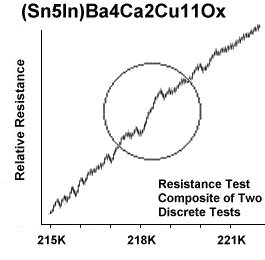
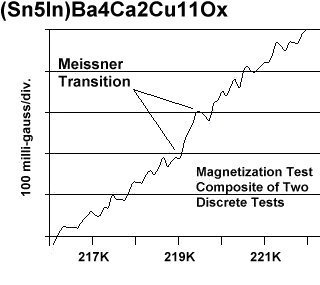
218K Superconductor Signature Resolved
World Record Rises 80 Degrees Since May 2006
29 January 2009
Superconductors.ORG
Signs of superconductivity near 218 Kelvin, reported by
Superconductors.ORG as a minority phase on November 30, 2008, have now been confirmed. Resistive and diamagnetic
transitions have been resolved using an established digital summing technique. Those results - typically 10db
over noise - were then used to contrast samples of differing stoichiometries to identify the probable structure type.
The material
producing the 218K signal appears to have the chemical formula
(Sn5In)Ba4Ca2Cu11Oy.
This conclusion was reached after comparing samples with 10 atoms of copper per unit cell to those with 11 atoms of copper
per unit cell. In brief, those with 10 copper atoms produced a strong 212K signal, and a weak 218K. Those
samples with 11 copper atoms produced a strong 218K signal, and a weak 212K, as seen in the below right plot.
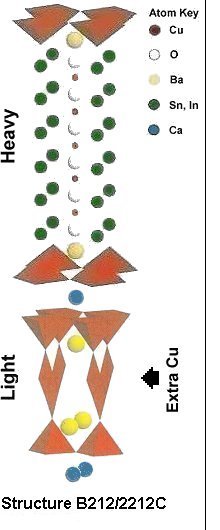
|
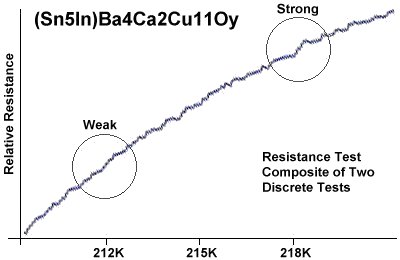
An additional copper atom positioned into the 1212C chain of the B212/1212C structure
(where B=11 and C=copper chain) causes a branching of the copper chain, creating a B212/2212C structure (shown at left).
This extra copper atom increases the hole content of that insulating layer and further stiffens the lattice, raising Tc.
Even though the copper chain branches, the planar weight ratio remains high
along the C axis. As with the 212K, 200K, 195K, and prior discoveries, planar weight disparity is the driving force
behind these extraordinarily high Tc materials.
|
An analog to this increase in Tc exists in the difference between Y-123 (Tc~92K, shown
below left) and Y-247 (Tc~95K, below right). Y-123 has a colinear C axis, while Y-247 branches to accommodate an extra
copper atom.


The graph below shows the relationship between
Tc and planar weight ratio. In the highest range of Tc's the curve rolls over and begins
to flatten.
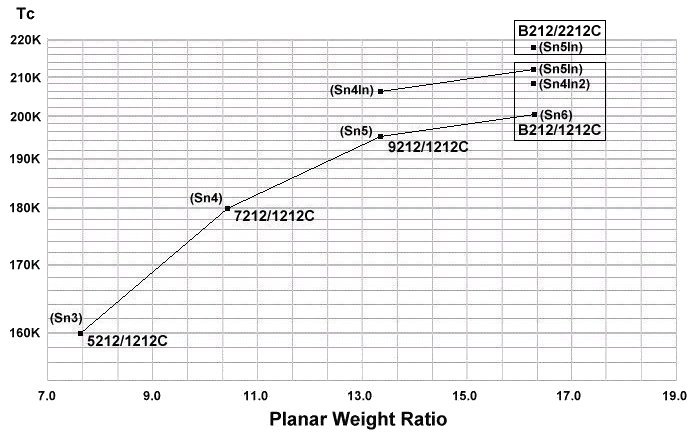
Synthesis of these materials was by the solid state
reaction method. Stoichiometric amounts of the below precursors were mixed, pelletized and sintered
for 36-60 hours at 830C. The pellet was then annealed for 10 hours at 500C in flowing O2.
SnO 99.9% (Alfa Aesar) 4.64 grains
In2O3 99.9% (Alfa Aesar) 0.96 grains
CaCO3 99.95% (Alfa Aesar) 1.38 grains
BaCuOx 99.9% (Alfa Aesar) 5.98 grains
CuO 99.995% (Alfa Aesar) 3.84 grains
The magnetometer employed twin Honeywell SS94A1F
Hall-effect sensors with a tandem sensitivity of 50 mv/gauss. The 4-point probe was bonded
to the pellet with CW2400 silver epoxy and used 7 volts on the primary.
RESEARCH NOTE: The copper-oxides are strongly hygroscopic.
All tests should be performed immediately after annealing.

E. Joe Eck
© 2009 Superconductors.ORG
All rights reserved.
 BACK to "News" page at Superconductors.ORG
BACK to "News" page at Superconductors.ORG











 BACK to "News" page at Superconductors.ORG
BACK to "News" page at Superconductors.ORG